Pig-human Hybrids
Reports
Mammalian Hybrids
Some readers may find the contents of this page disturbing.
This page was part of a draft for a chapter on this topic that has now been published in its finished form in my book Telenothians, which is available here.
There are many newspaper reports about putative pig-human hybrids, a broad selection of which appear below. Such animals, when birthed by a sow, are generally described as having a humanlike face, with a rounded skull, close-set or, often, even cyclopian, eyes. In several cases, eyes are absent. The reported degree of similarity to a human physiognomy varies from one specimen to another, but hairless facial skin and the presence of a chin are often mentioned. The ears usually described as like those of a pig, but turned toward the rear, as in humans, instead of being upright, as in pigs (some reports mention animals with one pig ear and one human ear). Many of the specimens, instead of a snout, breath through a process similar to a short elephant’s trunk attached to the forehead (frontal proboscis), which, together with the rearward-turned ears, results in some of the specimens being described as piglets with the head of an elephant. The hooves of these creatures often curl at the end like a ski tip. Some reportedly have human hands, but generally speaking, most such births are piglike from the shoulders back. The reverse, however, holds true for most individuals reported as having been birthed by women, that is, many of these supposedly have pig heads and human bodies.
But now, to the reports...
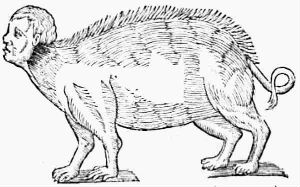 An illustration from an old report about the birth of a pig-human hybrid (such births were recorded even in ancient times).
An illustration from an old report about the birth of a pig-human hybrid (such births were recorded even in ancient times).
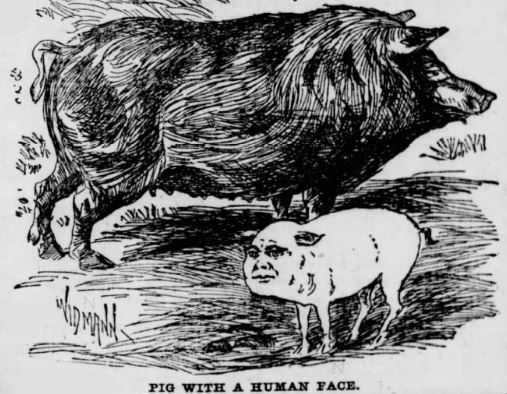 Above: a picture from the St. Louis, Missouri, Post-Dispatch (Aug. 26, 1896, p. 29), which accompanied the report below.
Above: a picture from the St. Louis, Missouri, Post-Dispatch (Aug. 26, 1896, p. 29), which accompanied the report below.
Brooklyn, New York. The following report, about a pig with an old man’s face, appeared in the St. Louis, Missouri, Post-Dispatch (Aug. 26, 1896, p. 29):
A Strange Pig
With the Face of a Pleasant-looking Old Gentleman
The pig is dead and is preserved in a spirit jar, which enables its strangely human features to be inspected.
The pig’s head differs from a human being’s only in having the long, pointed ears belonging to normal members of its family. This gives it somewhat the appearance of a goblin or other creature of the imagination, with a partly human shape.
The head, apart from the ears, is like that of an old man. It is free from all hair except eyebrows. These are well grown and are a remarkable abnormality in a pig. The forehead is high and the skull is rounded at the top of human shape. It suggests considerable intelligence and a well-balanced character.
The whole face is oval in shape and is similar to that of an old man of dignified appearance. There is rather too little nose for a very good looking man, but still, this member is distinctly human in shape. It is small and snub, and is utterly different from the sharp snout of a the pig
The chin is heavy and well rounded. It is perhaps the most human of all the features. The eyes are much larger than those of an ordinary pig. The skin is as white and smooth as that of a delicate woman. Although it must be called a monster, on account of its strange physical abnormality, the little pig is not repulsive. On the contrary, it is quite amusing in appearance. If it were alive and well, it would be a decidedly interesting animal to have about the house.
How it came to die is a curious story. It was born on May 12 last on a rancho near Arecibo, on the island of Porto Rico, in the West Indies. The mother produced only this one animal at the time, itself a very unusual circumstance.
In spite of its grotesque appearance the little pig seemed to enjoy good physical health. But his mother had no affection for him. She was disgusted and alarmed at his unnatural features. She gave him little nourishment, and in consequence he died on May 18. The fact that he remained alive for six days in a half starved condition shows that he must have entered life with fair health.
The mother is a perfectly black sow and perhaps this fact increased her feeling of repulsion for a young one with human features and a very white skin.
Peruville, New York. Another case originating from New York (a specimen from near Peruville) is described in a French language publication Le Voleur Illustré (Aug. 28, 1884, pp. 557-558), which states that the natural history collection of Cornell University had recently acquired a piglet with the face of a woman, "and indeed of a pretty woman." According to the report the eyes, ears, mouth and dimpled chin were all those of a human being.
Elizabeth City, North Carolina. The following, a brief account of a pig born with a human face, appeared in the Wilmington, North Carolina, Journal (July 16, 1869, p. 1, col. 4):
Wilmington, North Carolina. The following is an account that appeared in the Goldsboro, North Carolina, Headlight (Dec. 24, 1896, p. 1, col. 4):
A Pig with Human Hands and Ears
Occoneechee Neck, North Carolina. The next report, another North Carolina case, describes a creature with human head, arms and hands, farrowed by a sow. It appeared in the Charlotte, North Carolina, Home and Democrat (Jun. 8, 1883, p. 2, col. 2):
South Point Township, North Carolina. The following is from the Anderson, South Carolina, Intelligencer (May 26, 1881, p. 2, col. 6). This report was first published in the Charlotte, North Carolina Observer.
On the place of a gentleman named McKee in South Point Township, Gaston County, about 15 miles from this city [i.e., Charlotte], is a pig, born like other pigs with the exception that where one of the fore legs ought to be is in place a perfectly shaped human hand with four fingers and a thumb, with well developed nails upon them. There is another exception. On the other fore leg is a toe like those of a human being. The pig is six weeks old. It carries its hand in front and parallel with the body as if in a sling and runs on its three legs much faster, even, than the other pigs with four. The owner of this pig wants $500 for him. A gentleman of this city, Mr. C. S. Mallard, who was at the farm yesterday and examined the monstrosity offered the owner $30 for it but understood from his reply that he couldn’t “touch it with a forty-foot pole.” Dr. J. C. Bauman, a practicing physician of Gaston County, made a scientific examination of it and says the bones and ligaments are those of a perfectly formed hand. It will doubtless prove to be worth all the owner asks for it.—Charlotte Observer, May 15.
Hawaii. A brief notice appeared in the Pacific Commercial Advertiser (April 7, 1883, p. 5, col. 3), which reads "A correspondent on Hawaii writes us that in a litter of twenty-eight little pigs there was one with a human head, chest like a man, teeth an inch long, fore legs like a man, no tail."
Napoleon, Ohio. The following is an account of a pig born with human hands, which appeared on the front page of the Napoleon, Ohio, Democratic Northwest and Henry County News (Jul. 4, 1895, p. 1 ):
A Monstrosity
A Pig with Human Hands
Mr. Albert C. Knipp, who resides five miles south of Napoleon on the farm of the late Peter Knipp, reported the birth of a monstrosity on Saturday, in the shape of a pig, which instead of having natural legs and feet had three appendages which resembled the human arm upon which are three shapes like the human hand. The other leg and foot is natural.This monstrosity is one of a litter of pigs numbering fifteen, twelve of which are living, and in all respects it is healthy with good prospects of maturing. Mr. Knipp intends to care for it and take all the necessary pains to have it live, and if he is successful will exhibit the curiosity at the Napoleon Fair this fall.
Lansdale, Pennsylvania. An additional account of a pig born with human hands appeared in the Cambria Freeman (Mar. 26, 1880, p. 2 col. 4), published in Ebensburg, Pennsylvania:
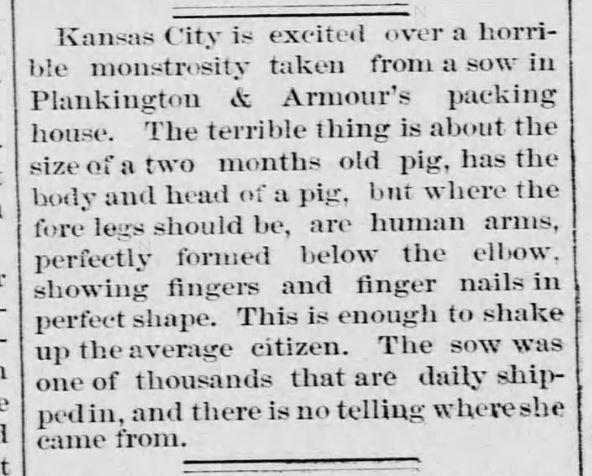 A news report describing a fetus with human arms and hands found in a slaughtered sow. The notice appeared in the Winfield, Kansas, Cowley County Courant (Dec. 22, 1881, p. 2), but the same account appeared in many American newspapers.
A news report describing a fetus with human arms and hands found in a slaughtered sow. The notice appeared in the Winfield, Kansas, Cowley County Courant (Dec. 22, 1881, p. 2), but the same account appeared in many American newspapers.
Reading, Pennsylvania. The next report is from the Hickman, Kentucky Courier (Nov. 20, 1885, p. 4, col. 6). It originally appeared in the Reading, Pennsylvania Times.
A Pig With an Arm and Hand
Henry Sclater, of Norristown, has a litter of seven young pigs, one of which is a monstrosity of an unusual type, combining with its porcine construction a portion of the human anatomy. The left forelimb, instead of being a leg, is like the arm of an infant. At the extremity is a hand, containing a thumb and four taper fingers, which are regular in form, even to the nails.
Decatur, Indiana. Next, a notice about a pig with human hands from the South Bend News-Times (Apr. 2, 1915, p. 6, col. 5):
Evolution of the Human Hog
(Decatur Democrat)D. M. Hensley, the well known taxidermist in this city, is busily at work stuffing the little pig which was born on the Gephart farm some days ago, the feet of which resembled the hands of a human being. The pig is a freak and Mr. Hensley will have it on display in a few days. It will no doubt attract attention.
Indianapolis, Indiana. Another Indiana report is the following notice from the Indianapolis Journal (Jun. 8, 1892, p. 8, col. 4):
A Curious Freak
Mrs. Mary Mason, who is a grocerykeeper, has a freak of nature in the form of a pig which was born with a human faoe. It lived only eleven hours and has been preserved in alcohol. It was one of a litter of eleven, the rest of which did not offend nature.
South Norwalk, Connecticut. Later that same month, a second pig-human hybrid was reported in the Guthrie, Oklahoma, Daily Leader (Apr. 23, 1915, p. 6, col. 6):
HALF PIG, HALF HUMAN
REMARKABLE MONSTROSITY
South Norwalk, Conn., April 23—A pig with ears, nose and mouth almost human in character, yet otherwise a perfect pig, was born here and is causing a tumult among scientists. The pig was born in the piggery of Albert Kunze, and while a sow usually gives birth to eight or ten pigs, this porcine monstrosity carried out its human resemblance by being born alone.
Rockport, Missouri. A Missouri hog-human was announced in a notice in the San Bernardino, California, News (Jun. 2, 1914, p. 1, col. 6):
THIS HOG HAS HUMAN FACE, IS DECLARED
ROCKPORT, Mo., June 2.—Mrs. Lillie L. Breauzeal of this town has a freak hog which is different from anything ever heard of here. The front of the head of the animal resembles a human face and it has no hoofs. It is without hair except small patches over its eyes.Sturgis, Kentucky. Another brief article appeared in the Marion, Kentucky, Crittenden Record (May 21, 1908, p. 1, col. 6):
Pig Has Human Face
Sturgis, Ky., May 16th.—Perhaps one of the most peculiar freaks ever known is the human-faced pig now three days old, at the home of J. S. Hancock, on the E. B. Jones farm.
Mrs. Hancock feeds the pig with a spoon as she would feed a baby. The mouth, nose, eyes, forehead and chin are identical with that of a human. It is one of ten pigs having a body as perfect as any of them.
Louisville, Kentucky. The following is a report from the Memphis, Tennessee, Public Ledger (Aug. 8, 1867, p. 4, col. 1):
A Curious Monster
Pendleton, Oregon. Next, a notice about a pig with one human arm and four human hands. It appeared in the Pendleton newspaper East Oregonian (Dec. 3, 1904, p. 2, col. 2):
A freak is to be seen at the farm of Frank Gagnon, five miles south of town on the reservation. It is a well developed pig, born with a litter of several others, but differing from them in this point: For one leg and foot it has a perfectly formed arm and hand, and on the remaining three legs, instead of feet, are hands. The mother sow refuses to accept her freak offspring, and Mrs. Gagnon is raising it “on the bottle.” She has refused two offers, one of $50 and one of $100 for the animal.—Athena Press.
Friendship, Tennessee. The next, rather well-attested, report appeared in the Memphis, Tennessee, Daily Appeal (Nov. 31, 1877, p. 4, col. 3). In the nineteenth century the Latin term lusus naturae, meaning “sport of nature,” was often used in reference to surprising freaks and mutations.
A LUSUS NATURAE
The Pig Born in Friendship, Crockett County, with a Human Head and Face—Statement of Eye-Witnesses
To the editors of the Appeal.
FRIENDSHIP, CROCKETT CO., August 28.— Having seen a statement going the rounds of the papers that a pig with a human face was found near Dyersburg on the seventh instant [i.e., Aug. 7, 1877], we propose to make some corrections and give the case alluded to more in detail: Said pig was delivered of a fine young Berkshire sow in this village and county on the fourth instant, and was one of a litter of ten pigs. The sow had been bred to a Jersey red boar previously and, as stated, brought a litter of ten pigs on the fourth instant. The entire litter was beautifully spotted, red and black, exhibiting a genuine cross between the black and Jersey red. The pig in question was the fourth farrowed, and was dead when expelled. It was brought to our office in a few minutes afterward by Mr. Wyatt Lunceford, of this place. It was a perfect, well-developed pig, from its head back. Its head was shaped after that of a rather thin-visaged child, with a perfect, though rather narrow, human face. The nose resembled a human nose, somewhat shrunken from loss of the nasal bones. The right ear was a well-formed hog’s ear, while the left, in rather a rudimentary state, resembled a human ear. The hair on the head was uniformly red, very soft and downy, making quite a contrast with the coarser spotted hair covering the body. The face, including the forehead, which was very high and free from hair, was perfectly smooth and as tender as an infant’s. That portion of the head formed by the frontal and temporal bones was as perfect human in resemblance as could be. The eyes, when the lids were drawn apart, presented a beautiful blue color, with a freshness unusual in a dead infant. Its tongue was wide and thin, just like an infant’s tongue. It had but one tooth, and that was a perfectly formed incisor. This monster pig was put by us in alcohol, and intended to be preserved for future study, but unfortunately it began to decay in a few days, and our best efforts to preserve it were unavailing. It was visited, however, by hundreds of people (and among the number several intelligent physicians), by whom the above facts can be corroborated. If we had not felt confident that we could preserve it, we would have had its photograph taken, which we now exceedingly regret not doing. Respectfully,
M. M. Smith, M.D.
The following report, which originally appeared in the Dyersburg Gazette, refers to the same case as that immediately above, and is taken from the Clarksville, Tennessee Weekly Chronicle (Sep. 1, 1877, p. 1):
Pig with a Human Head
Dyersburg Gazette
Burlington, Iowa. The next report appeared in the Terre Haute, Indiana, Daily Wabash Express (Feb. 1, 1871, p. 2, col. 1):
A Freak of Nature.
Crawley, UK. A brief article about a pig-human appeared in The Merthyr Telegraph (Aug. 18, 1860, p. 4), a Welsh newspaper:
EXTRAORDINARY FREAK OF NATURE
A short time since Charles Mill, living at [the hamlet of] Crawley, near [the village of] Uley [in Gloucestershire], had a pig which brought forth young to the number of ten, several of which were more or less deformed, one in a most extraordinary and wonderful manner. It had the perfect form of a human face (with eyes, nose, mouth, teeth and tongue) which was perfectly upright. There were no hind legs, but two marks where legs ought to have been [the incidence of missing or stump appendages is elevated in hybrids]. There were two fore legs, on each of which were five fingers, and the hand represented a human being. The ears, which were not upright, but were situated along the side of the face, were half pig and half human in appearance. It was born alive. The face and forehead were quite bare of hair, but the hinder part was covered with hair, as of a pig. The circumstance caused much talk in the neighbourhood.
Ingeldorf, Luxembourg. A brief announcement of a piglet born with a human head appeared in the May 27, 1880, issue of Bogen des Neuigkeits Welt-Blatt, a newspaper published in Vienna, Austria:
Offenbach, Germany Another German-language report appeared in the September 8, 1837, issue of Regensburger Zeitung, a newspaper published in Regensburg, Germany:
Australia. An Australian case is described in the following notice from The Armidale Express and New England General Advertiser (Jan. 29, 1886, p. 4, col. 4), a newspaper published in Armidale, New South Wales.
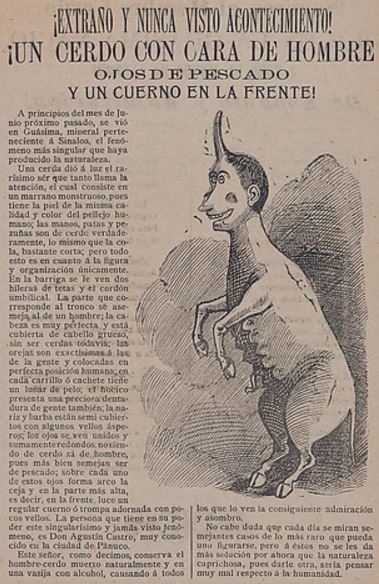 A broadsheet (printed ca. 1900) about a pig-human hybrid with an ostensible frontal proboscis born in the town of La Guásima in the Mexican state of Sinaloa.
A broadsheet (printed ca. 1900) about a pig-human hybrid with an ostensible frontal proboscis born in the town of La Guásima in the Mexican state of Sinaloa.
Pig-human hybrids with frontal proboscides:
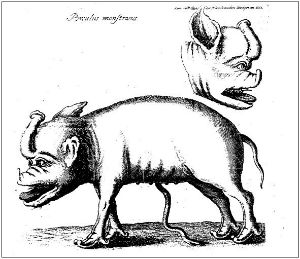 A probable pig-human hybrid with a frontal proboscis (from Screber 1751). This creature had one human ear and one pig ear. Enlarge
A probable pig-human hybrid with a frontal proboscis (from Screber 1751). This creature had one human ear and one pig ear. Enlarge
Births of this kind are frequently reported to have a structure similar to a short elephant’s trunk, known as a frontal proboscis. Various individuals with frontal proboscides are depicted on the pig-human videos page, and on pages linked to that page.
California. The following is a report about another such creature. It originally appeared in the Sacramento, California Union, but this transcript was taken from the Stroudsburg, Pennsylvania Jeffersonian (May 11, 1854, p. 1, col. 5):
Lusus Naturae
“Dropping into the K Street drugstore yesterday, we observed Dr. Logan busily engaged in his office, making a drawing of the most monstrous lusus naturae we ever saw. It was no less than an abortive attempt on the part of Dame Nature to manufacture a human being out of a hog. The animal had attained its complete fetal growth, and was one of a litter of well and naturally formed pigs. The particular one in question, however, is entirely destitute of hair, while the skin is white and smooth. The forehead and head are full and round, and at about the same facial angle as that of the Caucasian race. In lieu of the nose, a proboscis, in exact miniature shape of an elephant’s, proceeds from above and between the eyes, and rests on the upper lip. The eyes are large, round, and full as a man’s. The lower jaw and chin project beyond the upper, and the tongue protrudes a little beyond the lips. The ears are flattened, and laid back against the side of the head. Indeed, the whole contour and figure of the head and face are those of a human being while the rest of the strange animal partakes of the characteristic formation of the porcine species. We understand that this phenomenon was obtained by a gentleman of this city from one of the neighboring mining districts, and that he intends sending it to Europe, in order to give the savants there an opportunity to speculate concerning its formation.”
Florida. The next article describes a pig-human born in Jacksonville, Florida. The report appeared in the Terre Haute, Indiana, Saturday Evening Mail (Oct. 4, 1890, p. 3, col. 4):
A Pig with a Human Face
Charles A. Clark an undertaker and embalmer, has in his establishment the remains of a young pig, which is one of the greatest freaks of nature ever seen in Jacksonville, Fla. It is the property of E. A. Lindsey, of Springfield, and is one of a litter of eleven pigs. Ten of these pigs are perfectly formed and are thriving, but the one in question was born dead.
It is about twice the size of the other pigs of the same litter, and is perfectly hairless, except for a small patch of whiskers on the chin. The head of this freak is human shaped. The ears are set on the side of the head like those of a human being, but are larger and shaped like an elephant’s ear. The chin, mouth and cheeks are human shaped, while the teeth are like a shark’s. It has no nose, but instead a perfectly shaped trunk extends from the base of the forehead just where the root of the nasal organ should be.
Immediately under the root of the trunk is situated one large egg shaped eye, with two large, round pupils (one at each end of the eye), which peeps out from under and on either side of the trunk. Each pupil or eye is shaded by white eyebrows, which very much resemble the velvety brows of an infant. The trunk is nearly four inches in length and is perfectly pliable. The hoofs of the feet are goat shaped and turn up at the points like those of a mountain goat. Taken as a whole it is the most hideous looking object ever seen in Jacksonville.
Chattanooga, Tennessee. The following article, about a pig with a human face and an frontal proboscis, appeared in the Clarksville, Tennessee, Weekly Chronicle (Aug. 22, 1874, p. 2, col. 7):
The Chattanooga Times thus describes a monstrosity now on exhibition at a drug store in that city:
The curiosity in question is a pig, with the skin of a human infant, a human face in everything except a trunk with the exact conformation of the elephant’s. The skin is velvety, entirely devoid of hair. The face is a curious mixture of animal and human. The skin is all human, and so are the eyes and forehead; the eyes having well-defined brows. The forehead, chin, cheeks and nose, or trunk, make up a countenance not at all unlike one of Nast’s caricatures of Boss Tweed. The ears, body, legs, feet and tail are pig and nothing else. The trunk projects in the same place as the trunk of an elephant, and beneath it is a mouth so human in expression that it raises a doubt whether it can belong to an infant swine. The pig was born on a farm in the eleventh district and lived fifteen minutes after birth.
South Carolina. A brief article about a “pig” born with a human-like face and a frontal proboscis, from the Orangeburg, South Carolina, News (Sept. 19, 1874, p. 2, col. 4), published in:
A pig was born recently in Columbus with a half human face and head, perfect chin and mouth, signs of a large tusk on one side of the mouth, and a perfect elephant’s trunk extended from the forehead, with ears similarly shaped to those of an elephant. It will be an interesting fact to psychologists to know that a circus had passed through Columbus some months before this pig was born, and that there was an elephant with it. The maternal sow may have seen the elephant—hence the above monstrosity.†
Another South Carolina case, about two separate pig-humans born in the same litter, is here excerpted from a story in the Greenwood, South Carolina, Index-Journal (Nov. 23, 1934, p. 4, cols. 5 & 6; ||yy7eg49u), which told of a show coming to the local Lions club:
One of these half-human pigs has a perfect human head, has fingernails instead of hoofs, and before it died at the age of six days, cried like a baby. This pig has apparently two human eyes that grew together into one,‡ and other human features that are deeply amazing. The other pig, from the same litter, has a perfect human skull, large blue eyes, and three human teeth. It also died after living for a week.
These two pigs have created unusual interest wherever they have been exhibited, and the local Lions club feels that it is very lucky to secure the permission of the owner to exhibit them here in Greenwood for those who like to see and study such freaks of nature.…
Manawatu, New Zealand. Another report appeared the Wellington Evening Post (Feb. 19, 1876, p. 4):
The Manawatu Times says:—On Saturday, the 12th instant, at Mr. Waldegrave’s farm, near to this township, was born a pig—that is if the animal can any longer be classified a pig—that has an elephant’s head upon it. There is no exaggeration whatever in this statement; not only is the shape of the head of the elephant most clearly defined, but the trunk, about three inches long, is quite perfect. The mongrel lived for twenty-four hours, and is now in pickle awaiting further investigation. A fine subject, no doubt, for investigators of the Darwinian theory. The museum at Wellington should secure this strange monstrosity, being, we expect, the first of its kind.
Minnesota. The next report, about a “pig” with a human face, appeared the Warren, Minnesota Sheaf (May 12, 1892, p. 4, col. 4):
A "Human" Pig
A peculiar freak of nature has been discovered at Hubbard. Warren Watkins, a farmer, on going to his pigpen, found a monstrosity in the shape of a newly-born pig. The animal had an almost human face, and was considered one of the greatest curiosities ever seen in that vicinity. The body was naturally formed and differed in no respect from the ordinary pig.
A second report about the same birth mentions a proboscis. It appeared in the Courier Democrat (May 12, 1892, p. 4, col. 6), published in Langdon, North Dakota.
Ohio. The following is a brief article that appeared in the Belmont Chronicle (Jul. 23, 1891, p. 1), a newspaper published in St. Clairsville, Ohio. According to the account, a “piglet” born in Wellsville, a village in eastern Ohio, had human hands and a frontal proboscis, the "elephant trunk" referred to in the story.
Man, Elephant and Pig
A dispatch to the Cincinnati Commercial Gazette from Martin’s Ferry, reads: "Wellsville leads in the procession of monstrosities. It has a pig eight inches in length, which has four eyes, feet like the hands of a human, distinct fingernails and large ears. The upper part of its face is like that of an elephant, and the lower part like a human. There is a trunk projecting from the middle of the head, which turns backward and lies between the ears. In the end of the trunk are two large holes through which the freak breathes, there being no holes in the nose."
Note: The incidence of conjoined twins (and of the duplication of body parts as in the last quoted case) seems to be elevated in distant hybrids.
Louisiana. The next news story, about a “pig” born with a human head and frontal proboscis, appeared in the Opelousas, Louisiana Journal (Mar. 13, 1874, p. 3, col. 1).
Darwin’s Monkey Beat
Professor Rudolph Mayer, of this town, has a pig whose head and features, with the exception of the ears and snout, are those of a human being. The ears are those of a pig. The snout is neither pig nor human, but is a genuine snout like that of an elephant, hanging from the forehead. The skull is evidently human, having apparently the front and back brain, which no ordinary pig has. The face, eyes and mouth are all alike the human. The pig is about the size of a rat, and , with seven other ordinary pigs was taken from a sow that was slaughtered for pork. It is certainly a curiosity as it is, and would have been a greater one had it been born into actual life. It might have been taught to talk. The hog that goes about with the circus, and plays cards, etc., would have been nowhere beside this human pig. The fortunate owner of the person of this talking pig with human countenance, could have made a fortune exhibiting it, far greater than that of all the Rothschilds’ combined. How near he was to fortune and missed it! If he had only waited a few weeks linger, he would now be the possessor of the greatest living curiosity the world has probably ever seen. It costs nothing to see it now. Professor mayer has it in a small jar of alcohol. It is worth seeing.
Another case was briefly mentioned in the New Orleans Daily Crescent (Jan. 26, 1854, p. 2, col. 3). The notice said that in a hog undergoing slaughter a worker at a pork packing establishment in that city, “discovered a pig with a correctly developed human face, and its front legs growing out from the sides, with terminations to each resembling the four fingers of a child.”
New Zealand. Another report appeared in the Reefton, New Zealand, Inangahua Times (Jan. 16, 1882, p. 2):
Another case was described in the Wanganui, New Zealand, Herald (Jun. 16, 1868, p. 2):
A bizarre case
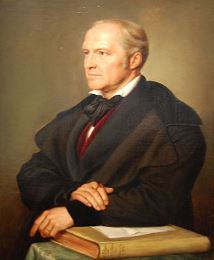 Carl Gustav Carus
Carl Gustav Carus1789-1869
Hildburghausen, Germany. Carl Gustav Carus (1789-1869) was a German physician who was also a naturalist, anatomist and painter. A friend of Johann Wolfgang von Goethe, Carus was credited by Sigmund Freud with originating one of the fundamental concepts of psychology, the unconscious.
During the course of his anatomical work, Carus published a detailed description of the head of an ostensible pig-human hybrid farrowed by a sow. (Carus 1841). This specimen had been sent to him from Hildburghausen by a certain Dr. Hartenstein. Carus not only wrote a lengthy description of his findings during the dissection of this head, but also employed his artistic talents to create a fine quality copper plate illustration of the specimen (shown below), and he explicitly states that its appearance is “very faithfully represented” (“sehr treu wiedergegeben”) by this illustration. This specimen is extremely unusual, not because it was a cyclops with a frontal proboscis, which are both features frequently seen in alleged human-pig hybrids, but rather because the site, of what in other specimens would have been a cyclopean eye, is filled by what appears to be a human face. This individual, then, represents a pig with a human parasitic twin. This bizarre tertium quid was born alive.
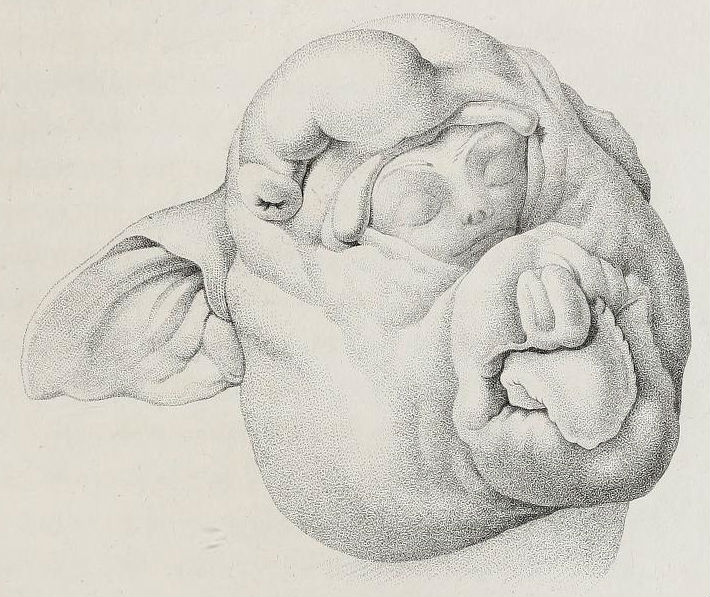 The head of a cyclopean ostensible pig-human hybrid with a frontal proboscis, and a human face on, or in place of, its single eye, as depicted by Carl Gustav Carus. Carus states that the appearance of the specimen is “very faithfully represented” (“sehr treu wiedergegeben”) by this illustration (copperplate engraving, source: Acta Academiae Caesareae Leopoldino-Carolinae Germanicae Naturae Curiosorum, 1841, vol. XIX, p. 2, Plate LXXIV).
The head of a cyclopean ostensible pig-human hybrid with a frontal proboscis, and a human face on, or in place of, its single eye, as depicted by Carl Gustav Carus. Carus states that the appearance of the specimen is “very faithfully represented” (“sehr treu wiedergegeben”) by this illustration (copperplate engraving, source: Acta Academiae Caesareae Leopoldino-Carolinae Germanicae Naturae Curiosorum, 1841, vol. XIX, p. 2, Plate LXXIV).
A similar case in Hawkinsville, Georgia. Remarkably, at least on the basis of the description given in the news report below, a different case would have been nearly identical to the hybrid described by Carus above. The report quoted here appeared in the Perrysburg, Ohio, Journal, (Jul. 30, 1914, p. 14, col. 3), but also appeared in many other newspapers around the country.
Pig has Human Face in Eye
Freak Porker also has Elephant’s Trunk and is Hairless
Hawkinsville, Ga. — Joseph Fleischman, a merchant of this town, is the owner of one of the greatest freaks of nature ever seen in this part of the south. It is a pig which has a human face in its eye and two noses, one a normal pig’s snout, and the other a diminutive elephant’s trunk, the latter growing from its forehead [i.e., a frontal proboscis]. It has no hair on its body. Fleischman bought the pig from a farmer living half a mile from here.
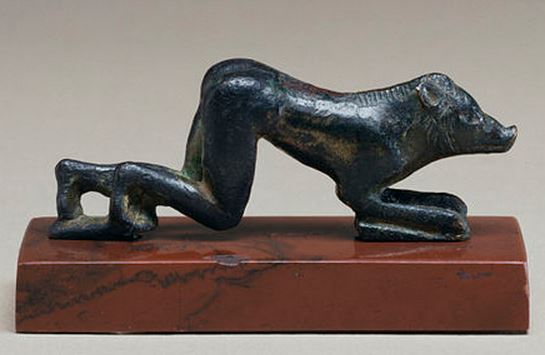 Human-pig hybrid (Greece, 5th century, B.C., Walters Art Museum, Baltimore, Maryland).
Human-pig hybrid (Greece, 5th century, B.C., Walters Art Museum, Baltimore, Maryland).
Human mothers
|
If a woman gives birth to a child with a swine’s head, offpring and wealth will increase in that house.
—A Mesopotamian birth omen‡
|
The great majority of reports about pig-human hybrids allege a sow mother. However, in some cases the reported mother is a woman. The number of available reports is limited, but in such cases, the reported structure of the offspring generally seems to differ from the usual rule (human foreparts, pig hind parts). Instead, there seems to be a greater tendency for the foreparts to be pig-like, and the hind parts, like those of a human.
The following is from the Logan County Enterprise, published in Russellville, Kentucky, but is here taken from the Hartford, Kentucky Herald (Dec. 18, 1878, p. 1):
This report appeared in the San Francisco newspaper Daily Alta California (Sep. 6, 1871, p. 1, col. 5):
Singular Malformation
The Harrison (Iowa) Harrisonian says that on the 2nd inst. a child was born in that town, the body of which was human in form, and the head resembled a pig. The mouth and chin rested on the chest, there being little or no neck, and in the mouth were two tusks resembling a hog’s tusk, some one-half or three-fourths inches long. The eyes were large, and presented a hog-like appearance; there was no forehead, but away back on the apparently brainless head were two pig’s ears—shape, size and all. Across the back, below the shoulders, was a thick, dark stripe; the arms were very long, the feet extra large, and the body heavy and well-developed. It came into the world alive, but died in a few minutes. … [Speculation about the cause of this abnormality omitted here.]
Gottfridi (1710, p. 1133) states that at Amsterdam, on April 17, 1611, a woman gave birth to a child with a pig’s head with one pig’s ear and one human ear. So this case resembles the other, more recent ones quoted on this page, in which a woman served as the mother in this cross, and the features of the resulting hybrid are the reverse of the usual configuration, that is, in these cases involving a human mother, the foreparts are pig-like and the hind parts are human-like.
Franck (1585, pp. 1020-1021), too, describes a creature with a pig-like face birthed stillborn by a woman in a village near Mühlhausen, Thuringia, Germany, in 1564. Indeed, according to the account, this birth had few human features.
Another report involving a human mother appeared in many U.S. newspapers in 1868, but the following was taken from the Hickman, Kentucky Courier (Jun. 27, 1868, p. 2, col. 3):
A German language news report, about a viable pig-human hybrid with atypical structure and a human mother, appeared in the Austro-Hungarian newspaper Agramer Zeitung (Feb. 15, 1896, p. 7, col. 1). In English translation, it reads as follows:
In addition, Rösch, et al. (1844, pp. 172-173, Observation 53) describe a 41-year-old male with pea-sized testicles (hybrids often have small testicles), birthed by a woman, but who had a head “more like that of a pig than a human being.”
However, a report about a birth that supposedly occurred in the Democratic Republic of Congo in 2016, if accurate, would show that such offspring do not always have the foreparts of a pig when birthed by a woman. The following account† appeared on line in African French-language news sources.
Parentage doubtful. There is another case that may refer to a human mother. Here, however, the structure seems typical (human head, pig hind parts). But note that, although a woman was accused, the true parentage of the creature in question was never determined. The following transcript was taken from the Stanford, Kentucky Interior Journal, (Feb. 12, 1884, p. 4, col. 3). The story originally appeared in the Richmond Register, another Kentucky newspaper.
A Horrible Monstrosity
|
A beggar and her children once went to a house to beg; but the beggar was told by the woman who came to the door to get away with her little pigs (meaning the children). This woman soon after gave birth to a child with a pig’s head.
|
Cyclopia and anophthalmia
Reports about distant hybrids, such as those quoted on this page, refer to cyclopia and anophthalmia at frequencies that seem to indicate a higher incidence of these conditions than in ordinary births. Anophthalmia is the congenital absence of eyes. The following brief report, for example, is about an anophthalmic “pig” with a human head, from the Fisherman & Farmer (May 29, 1896, p. 2, col. 4), published in Edenton, North Carolina.
A Curious Freak
A curious freak of nature can be seen at the farm of R. C. Ansell, living near Blackwater, Va. It being no less than a young pig that is part human. It has a human head, also jaws, nose, eyebrows and feet — there being no eyes at all, and no hair on the body. It is quite a curiosity. Dr. W. K. Wood has it preserved in alcohol.
A brief article, which reported a cyclopean “piglet” with a human head, appeared in the Daily Public Ledger (Nov. 3, 1896, p. 1, col. 6), a newspaper published in Maysville, Kentucky:
Another such cyclops was described in the Sedalia, Missouri Weekly Bazoo (Apr. 9, 1889, p. 6, col. 4):
A Lusus Naturae
A Sedalia Pig With One Eye and
an Elephant’s Trunk
Another report appeared in the German newspaper Tiroler Volksblatt (Mar. 17, 1875, p. 4, col. 1):
Two possibly imaginary cases
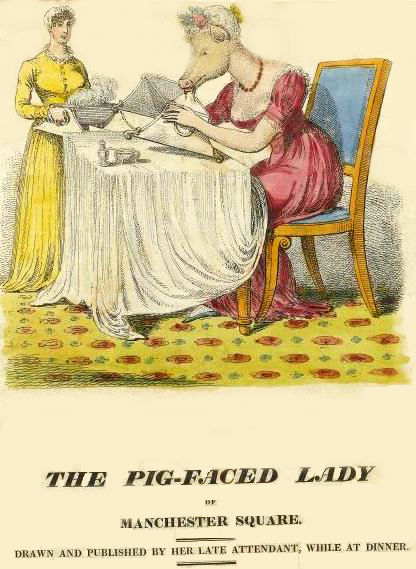 The Pig-faced Lady of Manchester Square feeding from her silver trough.
The Pig-faced Lady of Manchester Square feeding from her silver trough.
London. In late 1814 and early 1815, a rumor swept London that a pig-faced woman was then living in that very city (Bondeson 2006). Said to be the daughter of a noblewoman, she was supposedly young, wealthy and living in fashionable Manchester Square. In some reports she was described as the daughter of a noblewoman from Grosvenor Square. It was claimed that she would occasionally venture out of the house in a carriage, hidden by a heavy veil. This possibly imaginary being received heavy coverage in the British press and was widely discussed and ridiculed. The text originally accompanying the drawing above read typifies the reports:
Various are the reports which have gained circulation as to her Habits, Manners, Disposition, and Accomplishments, but all rest upon mere surmise, as she is never seen: she is perfect in her figure upwards to the head, which is that of a Pig. She feeds out of a Silver Trough, as represented in the above Print, is incapable of giving any other expression of her ideas than a grunt, and has not unfrequently been a source of terror to those who are employed about her person.
Offers of marriage have been made to her, by interested fortune hunters, amongst whom she is, doubtless, an object of irresistible attraction in consequence of the dazzling splendor of her family connections. In all the higher circles she is the universal topic of conversation; and curiosity is hourly employed in speculating upon the possible circumstances of her future life, as it is so greatly to the interest of her family that she should not die without issue, lest the title which distinguishes it should be come extinct.
Wirkham. A much earlier, but similar case, relates to a certain Tannakin Skinker, a pig-faced woman supposedly born in 1618 at Wirkham (possibly modern Woerden?) in the Netherlands. This case seems to have served as the model for the later story of the pig-faced lady of Manchester Square. The following is taken from an anonymously authored pamphlet printed in London in 1640:
If the joy of the parents was great in the hope of a Childe, how much greater may wee conjecture their sorrowes were, to be the parents of such a monster: but considering with themselves what Heavens would have, they had not power to hinder, and studying (as farre as in them lay) to conceale their shame, they so farre mediated with the Midwife and the other women that were present at the delivery, that they should keepe it as close and secret as it was possible to do: and they called the name of it Tannakin, which is as much in English as Anne, or Hannah.
By the same author: Handbook of Avian Hybrids of the World, Oxford University Press (2006).
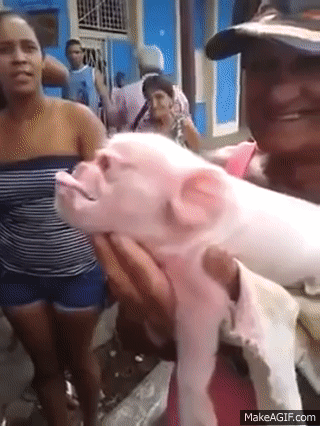 Pig-human hybrid videos >>
Pig-human hybrid videos >>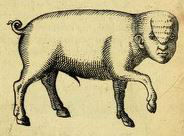 Historical Reports >>
Historical Reports >>